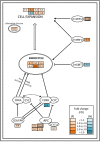Dissecting grain yield pathways and their interactions with grain dry matter content by a two-step correlation approach with maize seedling transcriptome
- PMID: 20385002
- PMCID: PMC2923537
- DOI: 10.1186/1471-2229-10-63
Dissecting grain yield pathways and their interactions with grain dry matter content by a two-step correlation approach with maize seedling transcriptome
Abstract
Background: The importance of maize for human and animal nutrition, but also as a source for bio-energy is rapidly increasing. Maize yield is a quantitative trait controlled by many genes with small effects, spread throughout the genome. The precise location of the genes and the identity of the gene networks underlying maize grain yield is unknown. The objective of our study was to contribute to the knowledge of these genes and gene networks by transcription profiling with microarrays.
Results: We assessed the grain yield and grain dry matter content (an indicator for early maturity) of 98 maize hybrids in multi-environment field trials. The gene expression in seedlings of the parental inbred lines, which have four different genetic backgrounds, was assessed with genome-scale oligonucleotide arrays. We identified genes associated with grain yield and grain dry matter content using a newly developed two-step correlation approach and found overlapping gene networks for both traits. The underlying metabolic pathways and biological processes were elucidated. Genes involved in sucrose degradation and glycolysis, as well as genes involved in cell expansion and endocycle were found to be associated with grain yield.
Conclusions: Our results indicate that the capability of providing energy and substrates, as well as expanding the cell at the seedling stage, highly influences the grain yield of hybrids. Knowledge of these genes underlying grain yield in maize can contribute to the development of new high yielding varieties.
Figures



Similar articles
-
Proteomic identification of genes associated with maize grain-filling rate.PLoS One. 2013;8(3):e59353. doi: 10.1371/journal.pone.0059353. Epub 2013 Mar 19. PLoS One. 2013. PMID: 23527170 Free PMC article.
-
Prediction of single-cross hybrid performance for grain yield and grain dry matter content in maize using AFLP markers associated with QTL.Theor Appl Genet. 2006 Oct;113(6):1037-47. doi: 10.1007/s00122-006-0363-6. Epub 2006 Aug 3. Theor Appl Genet. 2006. PMID: 16896712
-
Comparison of maize (Zea mays L.) F1-hybrid and parental inbred line primary root transcriptomes suggests organ-specific patterns of nonadditive gene expression and conserved expression trends.Genetics. 2008 Jul;179(3):1275-83. doi: 10.1534/genetics.108.088278. Epub 2008 Jun 18. Genetics. 2008. PMID: 18562640 Free PMC article.
-
A Comprehensive Transcriptomics Analysis Reveals Long Non-Coding RNA to be Involved in the Key Metabolic Pathway in Response to Waterlogging Stress in Maize.Genes (Basel). 2020 Feb 29;11(3):267. doi: 10.3390/genes11030267. Genes (Basel). 2020. PMID: 32121334 Free PMC article.
-
A reductionist approach to dissecting grain weight and yield in wheat.J Integr Plant Biol. 2019 Mar;61(3):337-358. doi: 10.1111/jipb.12741. Epub 2019 Jan 15. J Integr Plant Biol. 2019. PMID: 30421518 Free PMC article. Review.
Cited by
-
The differential transcription network between embryo and endosperm in the early developing maize seed.Plant Physiol. 2013 May;162(1):440-55. doi: 10.1104/pp.113.214874. Epub 2013 Mar 11. Plant Physiol. 2013. PMID: 23478895 Free PMC article.
-
Ancestor of land plants acquired the DNA-3-methyladenine glycosylase (MAG) gene from bacteria through horizontal gene transfer.Sci Rep. 2017 Aug 24;7(1):9324. doi: 10.1038/s41598-017-05066-w. Sci Rep. 2017. PMID: 28839126 Free PMC article.
-
GW2 Functions as an E3 Ubiquitin Ligase for Rice Expansin-Like 1.Int J Mol Sci. 2018 Jun 28;19(7):1904. doi: 10.3390/ijms19071904. Int J Mol Sci. 2018. PMID: 29958473 Free PMC article.
-
Candidate Genes and Quantitative Trait Loci for Grain Yield and Seed Size in Durum Wheat.Plants (Basel). 2021 Feb 5;10(2):312. doi: 10.3390/plants10020312. Plants (Basel). 2021. PMID: 33562879 Free PMC article.
-
Genome wide identification of Dof transcription factors in Carmine radish reveals RsDof33 role in cadmium stress and anthocyanin biosynthesis.Sci Rep. 2025 Feb 8;15(1):4766. doi: 10.1038/s41598-025-88308-6. Sci Rep. 2025. PMID: 39922841 Free PMC article.
References
-
- Rosegrant MW, Paisner MS, Meijer S, Witcover J. Global food projections to 2020: Emerging trends and alternative futures. Washington, D. C: International Food Policy Research Institute; 2001.
-
- Duvick DN. In: Advances in Agronomy. Sparks DL, editor. Vol. 86. New York: Elsevier Inc; 2005. The contribution of breeding to yield advances in maize (Zea mays L.) pp. 83–145. full_text.
-
- Tuberosa R, Salvi S. In: Handbook of Maize: Its Biology. Bennetzen JL, Hake SC, editor. New York: Springer; 2009. QTL for Agronomic Traits in Maize Production; pp. 501–541. full_text.
Publication types
MeSH terms
Substances
LinkOut - more resources
Full Text Sources
Molecular Biology Databases

